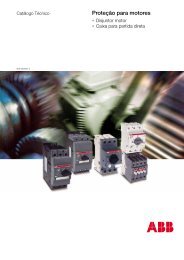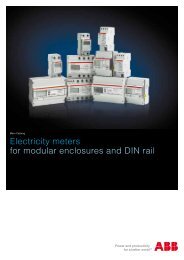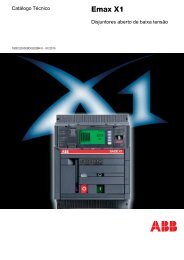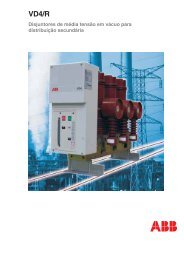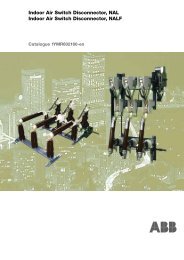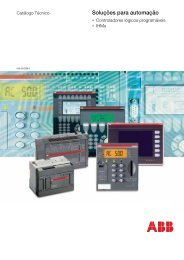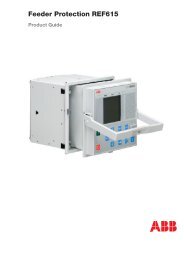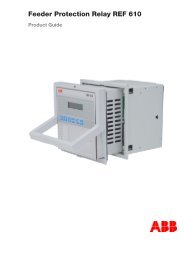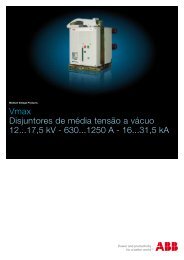Arc Protection Relay REA 10_ - APE Distribuidor ABB
Arc Protection Relay REA 10_ - APE Distribuidor ABB
Arc Protection Relay REA 10_ - APE Distribuidor ABB
Create successful ePaper yourself
Turn your PDF publications into a flip-book with our unique Google optimized e-Paper software.
<strong>Arc</strong> <strong>Protection</strong> <strong>Relay</strong> <strong>REA</strong> <strong>10</strong>_1MRS750929-MBG.Table 1: Minimum length (cm) of the exposed sensor fiber per one switchgearcompartmentFault current (rms)Distance between sensor and arc<strong>10</strong>0 cm 200 cm 300 cm 400 cm0.5 kA 20 - a - a - a0.7 kA 20 70 2<strong>10</strong> 2801.4 kA 20 20 20 1402.2 kA 20 20 20 20The information in the table 1 is based on thefollowing reference conditions:• Copper busbars• <strong>Arc</strong> length <strong>10</strong> cm• Surrounding light ~ 400 lux• No reflecting surfaces• Light reference level is set one scale markto the right from the minimumSensitivity of lens sensorsThe relative sensitivity of the lens sensorfrom different angles of lightning is presentedin figure 2. The normal operating sector is -130°... +130°. In practice, light is alsoreflected from the compartment walls, so thedetecting angle is not critical.The detection distance of a lens sensor is 3meters. Therefore, when protecting busbarsections, the maximum distance of lens sensorsfrom one another is 6 meters.Fig. 2a) Not operational.SensitivityAnglesRelative sensitivity of the <strong>REA</strong> lens sensorfrom different angles of lightingTrip outputThe trip output is provided with:• Two high-speed galvanically isolatedIGBT semi-conductor outputs, HSO1 andHSO2• <strong>Relay</strong> output, TRIP3The control signal of the outputs is activatedif the overcurrent signal and the light signal,but not the operating voltage fault signal, areactive at the same time.When the “Trip Condition” key switch on therelay’s front panel is in “Light” position, theovercurrent signal is constantly active, andtripping is activated by an arc alone. When atrip signal is delivered, the trip outputs arelatched in active state. The outputs can bereseted either by pushing the “Reset” buttonon the relay’s front panel, or by using a resetsignal applied to RESET input.Ports A and B for connecting extensionunitsThe selection switches are used to activate theports A and B.The extension units are connected to the portsA and B by using connection cables. Theextension unit receives its operating voltageand operation signals over the port.The ports are protected against short-circuitand cable breaks. If the connection cablefrom a port breaks, the concerned chain isdisconnected, and the fault LED (Port AFault” or “Port B Fault”) as well as the “IRF”LED on the central unit are lit, and the IRFrelay resets.A maximum of 5 extension units can be connectedto one port. If an extension unitincluded in the chain connected to the port isdamaged, the fault LED of the port startsflashing, the “IRF” LED is lit and the IRFrelay resets.5



